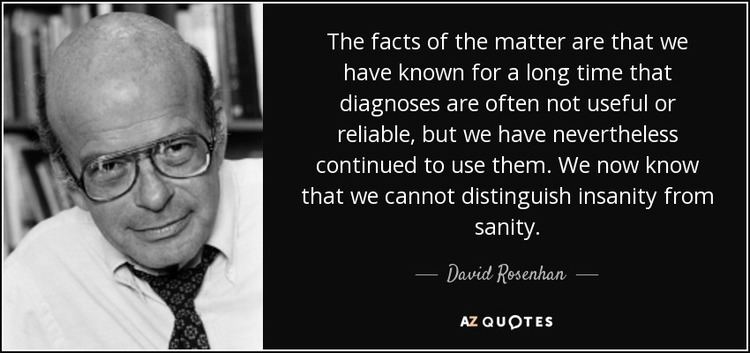Course description
WHO SAYS WHO IS MAD?
 David Rosenhan wondered what would happen if a number of entirely sane people tried to gain admission to a mental hospital by pretending to have one of the symptoms of insanity. Would these sane individuals be classified as insane? If they were admitted to the mental hospital, would the staff realize that a mistake had been made? The answers to these and other questions were obtained in a study in which eight normal people, five men and three women, tried to be admitted to twelve different psychiatric hospitals.
David Rosenhan wondered what would happen if a number of entirely sane people tried to gain admission to a mental hospital by pretending to have one of the symptoms of insanity. Would these sane individuals be classified as insane? If they were admitted to the mental hospital, would the staff realize that a mistake had been made? The answers to these and other questions were obtained in a study in which eight normal people, five men and three women, tried to be admitted to twelve different psychiatric hospitals.
 They consisted of a young psychology graduate, a paediatrician, a psychiatrist, three psychologists, a painter, and a housewife. The twelve psychiatric hospitals were in five different states on the east and the west coasts of America. They varied from relatively new to old and shabby, and from good staff-patient ratios to severe under-staffing.
They consisted of a young psychology graduate, a paediatrician, a psychiatrist, three psychologists, a painter, and a housewife. The twelve psychiatric hospitals were in five different states on the east and the west coasts of America. They varied from relatively new to old and shabby, and from good staff-patient ratios to severe under-staffing.
Each of the eight participants phoned the hospital asking for an appointment. On arrival at the admissions office, each of them complained of hearing voices (these voices were often unclear, but appeared to be saying “empty”, “hollow”, and “thud”; they sounded unfamiliar but were of the same sex as the ‘patient’).
The only important lies were about hearing voices and falsification of the participants' names and occupations; the significant events in each participant's life were described as they actually happened. All of these sane people were judged to be insane, and all of them were admitted to hospital, apparently because of their hallucinations.
As soon as these pseudo-patients had been admitted to the psychiatric ward, they stopped pretending to experience signs of abnormality, although several had a brief period of nervousness and worry, because they felt they would immediately be discovered as frauds.
 While they were in the psychiatric ward, the pseudo-patients said that they were fine and no longer experienced any symptoms. In general, they behaved in a friendly and co-operative way. The only unusual aspect of their behaviour was that they spent considerable time writing down their observations about the ward, its patients, and the staff. To begin with, these notes were written secretly, but as it gradually became clear that no-one took much notice, note-taking was done openly.
While they were in the psychiatric ward, the pseudo-patients said that they were fine and no longer experienced any symptoms. In general, they behaved in a friendly and co-operative way. The only unusual aspect of their behaviour was that they spent considerable time writing down their observations about the ward, its patients, and the staff. To begin with, these notes were written secretly, but as it gradually became clear that no-one took much notice, note-taking was done openly.
The hierarchical structure of the various psychiatric hospitals meant those with greater professional status had the least to do with their patients (and pseudo-patients). The average daily contact of the pseudo-patients with psychiatrists, psychologists, and doctors was 6.8 minutes. In view of this general lack of careful observation, it is not surprising that the pseudo-patients were not released very quickly. The actual length of hospitalization ranged from 7 to 52 days, with 19 days being the average.
 The fact that all the pseudo-patients were released within a few weeks of admission may suggest that the psychiatric staff discovered that the pseudo-patients had been sane all the time. However, this was not the case. All the pseudo-patients were discharged with a diagnosis of 'schizophrenia in remission', suggesting that the deception had not been discovered.
The fact that all the pseudo-patients were released within a few weeks of admission may suggest that the psychiatric staff discovered that the pseudo-patients had been sane all the time. However, this was not the case. All the pseudo-patients were discharged with a diagnosis of 'schizophrenia in remission', suggesting that the deception had not been discovered.
Interestingly, several of the real patients became suspicious about the pseudo-patients. The first three pseudo-patients were placed in wards containing a total of 118 patients. 35 voiced their doubts. They said things like, 'You're so not crazy. You're a journalist, or a professor. You're checking up on the hospital.' However most of them were reassured by the pseudo-patients saying that they had been sick before they came into hospital, though they felt fine when they had been admitted. Nevertheless a few of the bona-fide patients continued to voice the opinion that the pseudo-patients were sane.
If we accept these findings at face value, they suggest that the difference between the sane and the insane is so blurred that it is possible for the sane to be mistaken for the insane, at least by psychiatrists. Rosenhan wondered whether he could show the opposite effect, namely the insane regarded as sane. He used as his testing ground a research and teaching hospital. The staff there had heard about the study just described, and had informed Rosenhan that they would not have proved so gullible.
 The first thing that Rosenhan did was to tell the 100 staff of this hospital that one or more pseudo-patients would try to gain admission at some time during the following three months. Each member of staff was asked to observe all patients arriving for admission or in the ward and say whether they thought they were pseudo-patients or genuine patients.
The first thing that Rosenhan did was to tell the 100 staff of this hospital that one or more pseudo-patients would try to gain admission at some time during the following three months. Each member of staff was asked to observe all patients arriving for admission or in the ward and say whether they thought they were pseudo-patients or genuine patients.
Judgements were obtained on 193 patients admitted for psychiatric treatment. Forty-one genuine patients were judged with great confidence to be pseudo-patients by at least one member of staff. Nineteen patients were suspected of being frauds by one of the psychiatrists and another member of staff. In fact, none of Rosenhan's pseudo-patients tried to get admission during this time. Apparently, then, mental hospital staff do sometimes think that people committed to their care are sane.
Rosenhan's main conclusion, which is important if it is true, was as follows: 'It is clear that we cannot distinguish the sane from the insane in psychiatric hospitals.' Part of the problem may be that, under normal circumstances, doctors and psychiatrists are more likely to call a healthy person sick than a sick person healthy. It is obviously dangerous for a doctor to fail to take action when a sick person asks for treatment. A psychiatrist who refuses to hospitalize someone who has symptoms and asks to be hospitalized may face legal action if the patient later commits suicide or murder, so it is natural for him to be cautious.

 David Rosenhan wondered what would happen if a number of
David Rosenhan wondered what would happen if a number of  They
They  While they were in the psychiatric
While they were in the psychiatric The fact that all the pseudo-patients were released within a few weeks of admission may suggest that the psychiatric staff discovered that the pseudo-patients had been
The fact that all the pseudo-patients were released within a few weeks of admission may suggest that the psychiatric staff discovered that the pseudo-patients had been  The first thing that Rosenhan did was to tell the 100 staff of this hospital that one or more pseudo-patients would try to gain admission at some time during the following three months. Each member of staff was asked to
The first thing that Rosenhan did was to tell the 100 staff of this hospital that one or more pseudo-patients would try to gain admission at some time during the following three months. Each member of staff was asked to 
















